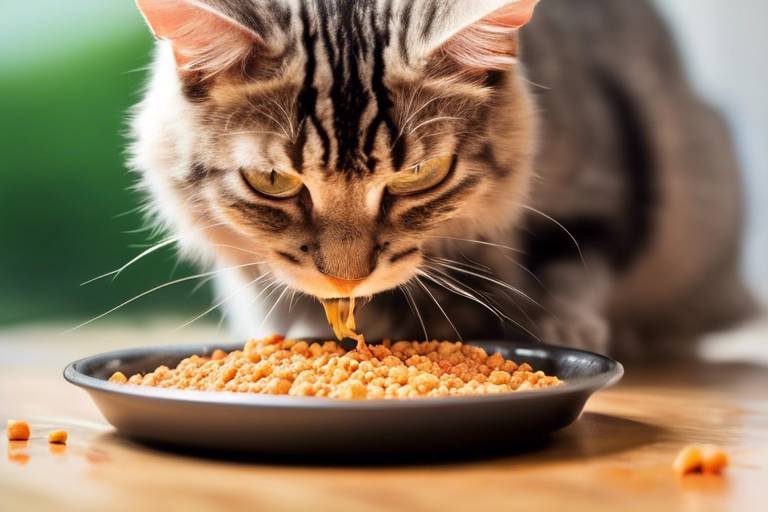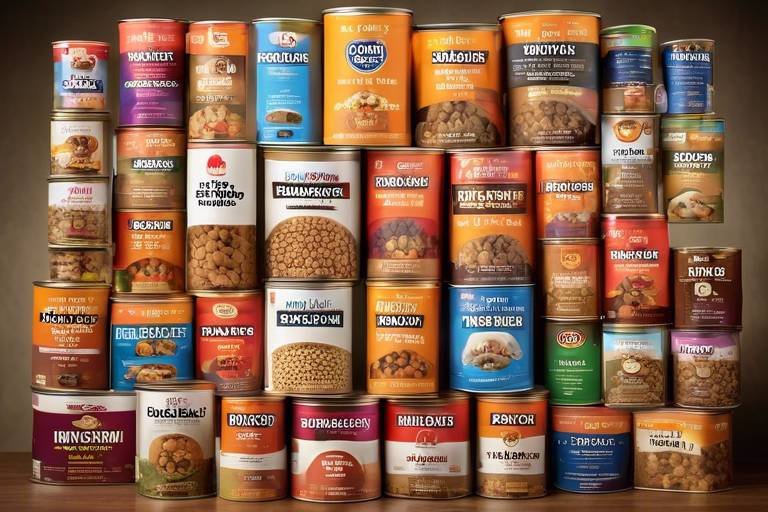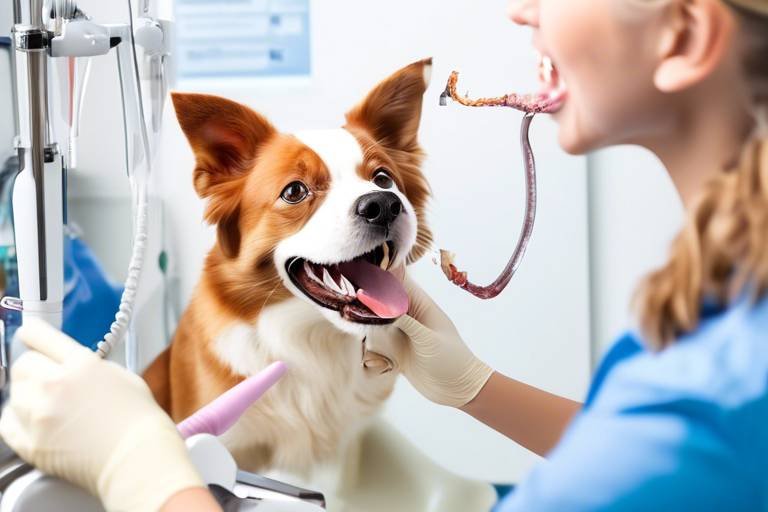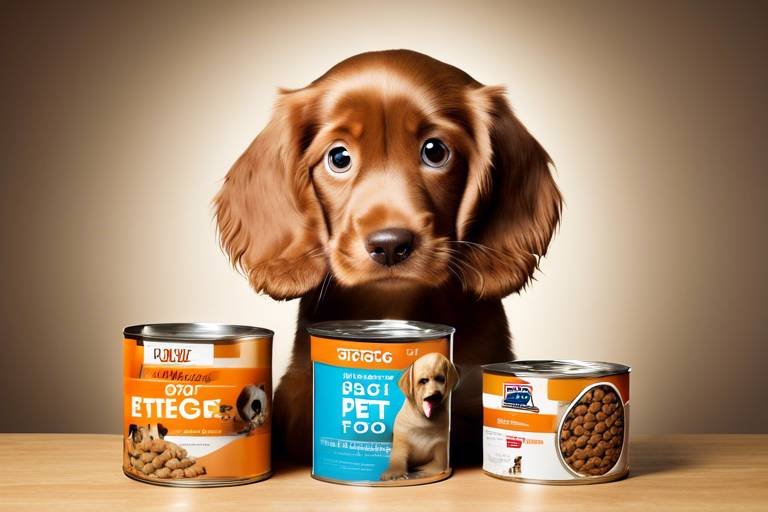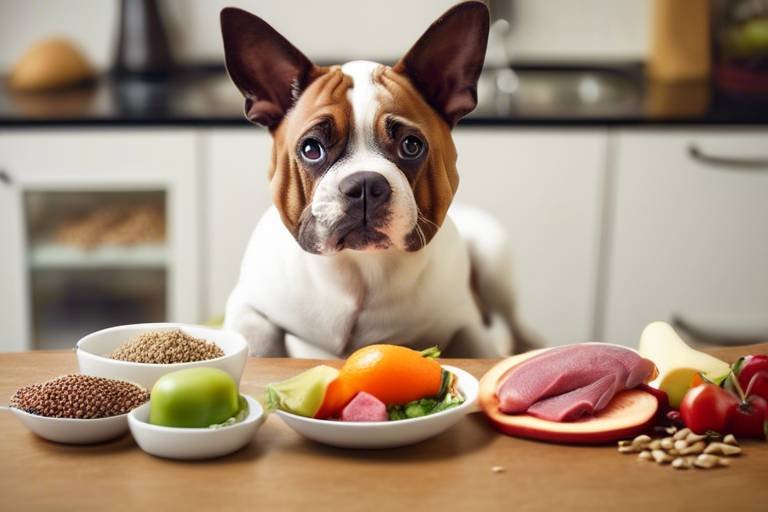Homemade Pet Treats - Healthy and Delicious Recipes
Are you tired of searching for the perfect treats for your furry friends? Well, look no further! This article explores various healthy and tasty homemade pet treat recipes, ensuring your pets enjoy nutritious snacks while keeping their dietary needs in mind. Making treats at home not only gives you control over the ingredients but also allows you to bond with your pets in a fun and creative way. Imagine your dog's wagging tail or your cat's purring as they savor a treat made just for them. Sounds delightful, right?
Discover the numerous advantages of making pet treats at home. First and foremost, you have complete control over the ingredients. This means you can avoid harmful additives and preservatives often found in store-bought treats. Plus, making treats at home can be a lot more cost-effective than buying premium brands. You can whip up a batch of treats for a fraction of the price and know exactly what your pets are munching on. And let’s not forget about customization! Each pet has unique dietary needs and preferences, so you can tailor the recipes to suit your furry friend’s tastes. Whether your dog loves peanut butter or your cat craves fish, the possibilities are endless.
When it comes to creating homemade treats, knowing what ingredients to use is key. Healthy options like whole grains, fruits, and vegetables are not only safe but also beneficial for your pets. Ingredients like oats, pumpkin, and sweet potatoes are fantastic choices that pack a nutritional punch. For cats, incorporating ingredients like tuna and chicken can make their treats irresistible. But remember, not all human foods are safe for pets. It’s crucial to do your research and choose wisely.
Understanding the importance of selecting pet-safe ingredients cannot be overstated. Just like us, pets can have food sensitivities and allergies. By being mindful of what goes into their treats, you ensure that they are both nutritious and safe for your beloved companions. Always check labels and do your homework before introducing new ingredients into their diet. And if you’re unsure, consult with your veterinarian for guidance.
Familiarize yourself with common human foods that are toxic to pets. Here’s a quick list to keep in mind:
- Chocolate
- Onions and garlic
- Grapes and raisins
- Nuts (especially macadamia nuts)
- Alcohol
Steering clear of these ingredients when preparing homemade treats will keep your pets safe and healthy.
Exploring alternative ingredients that cater to pets with allergies is essential. Some pets may have sensitivities to common ingredients like wheat or chicken. In such cases, consider using alternatives like gluten-free flour or fish instead of chicken. By doing this, you can create delicious treats without compromising their health.
Discover how to enhance your homemade pet treats with nutritional supplements. Adding ingredients like fish oil, probiotics, or vitamins can provide added health benefits and support your pet's overall well-being. These supplements can boost their immune system, improve coat health, and even aid digestion. Just be sure to consult with your vet regarding the appropriate amounts to use.
Now that you’re equipped with the knowledge of safe ingredients, let’s dive into some easy and nutritious recipes specifically designed for dogs. These treats not only promote health but also satisfy their taste buds, making treat time a joyous occasion.
Learn how to make delicious peanut butter and pumpkin biscuits, a favorite among dogs that are both tasty and packed with nutrition. All you need are a few simple ingredients: whole wheat flour, pumpkin puree, peanut butter, and an egg. Mix them together, roll out the dough, and cut out fun shapes. Bake them until golden brown, and watch your pup go wild!
Make wholesome sweet potato chews, a chewy and healthy alternative that dogs love. Simply slice sweet potatoes into thin strips and bake them at a low temperature until they’re chewy. These chews are not only delicious but also rich in vitamins A and C, making them a great snack for your furry friend.
Let’s not forget about our feline friends! Explore simple and nutritious homemade treat recipes for cats, ensuring your kitties enjoy flavorful snacks that contribute to their health.
Create tasty tuna and catnip bites that are irresistible to cats. Combine canned tuna, whole wheat flour, and a sprinkle of catnip. Shape them into small balls and bake until firm. Your cat will be meowing for more!
Prepare easy chicken and rice balls that are not only delicious but also packed with protein and essential nutrients for your cat's diet. Mix cooked chicken, rice, and a bit of broth, form them into balls, and bake. Your cat will love these savory snacks!
Q: Can I use any type of flour for pet treats?
A: While you can use various types of flour, whole wheat flour is a popular choice for dogs. For pets with allergies, consider using alternatives like oat or almond flour.
Q: How long do homemade pet treats last?
A: Homemade treats can last about a week in an airtight container at room temperature. If you want them to last longer, consider freezing them.
Q: Are there any ingredients I should avoid?
A: Yes, avoid toxic ingredients like chocolate, onions, and grapes. Always research any new ingredients you plan to use.
Q: Can I give my pet treats every day?
A: Treats should be given in moderation. They should make up no more than 10% of your pet's daily caloric intake.

Benefits of Homemade Pet Treats
Making homemade pet treats is not just a fun activity for you and your furry friend; it brings a plethora of benefits that can significantly enhance your pet's health and happiness. First and foremost, when you prepare treats at home, you have complete control over the ingredients. This means you can choose high-quality, nutritious components that align with your pet's dietary needs. Unlike store-bought options, which often contain fillers and preservatives, homemade treats allow you to ensure your pet is getting the best.
Another major advantage is the potential for cost savings. While it may seem easier to grab a bag of treats from the store, the long-term savings of making your own can be substantial. You can buy ingredients in bulk and create a variety of treats that cater to your pet's preferences. Plus, you won’t have to worry about the rising prices of commercial pet foods and treats, which can be quite steep!
Customization is another exciting aspect of homemade treats. Every pet is unique, with their own likes, dislikes, and dietary restrictions. By preparing treats yourself, you can tailor recipes to suit your pet’s specific needs. For example, if your dog is allergic to wheat, you can easily substitute with oat flour or other safe alternatives. This customization not only enhances your pet's enjoyment but also helps in maintaining their health.
Furthermore, making treats at home can strengthen the bond between you and your pet. Imagine the joy on your dog's face when they see you preparing their favorite snacks! Engaging in this activity together can create lasting memories and provide a sense of fulfillment for both of you.
To sum it all up, here are some key benefits of making homemade pet treats:
- Ingredient Control: Choose only the best for your pet.
- Cost Savings: Save money in the long run.
- Customization: Tailor treats to meet dietary needs.
- Bonding Experience: Enjoy quality time with your pet.
Overall, the benefits of homemade pet treats are undeniable. Not only do they promote better health and wellness for your furry companions, but they also offer a delightful way to show your love and care. So why not roll up your sleeves and start creating some delicious, nutritious snacks today?

Essential Ingredients for Pet Treats
When it comes to crafting homemade pet treats, the ingredients you choose play a crucial role in ensuring your furry friends receive the best nutrition possible. Just like we carefully select what goes into our meals, we must do the same for our pets. Using healthy, natural ingredients not only enhances the flavor of the treats but also supports your pet's overall health. So, what should you include in these delightful snacks? Let’s dive into some essential ingredients that are both safe and beneficial for your pets.
First off, whole grains are a fantastic base for pet treats. Ingredients like oats, brown rice, and whole wheat flour provide a great source of energy and fiber. They help keep your pets feeling full and satisfied, much like how a hearty bowl of oatmeal can fuel your morning. Additionally, incorporating fruits and vegetables into your recipes can add a burst of flavor and a wealth of vitamins. Think about sweet potatoes, carrots, apples, and blueberries. These ingredients are not only tasty but also packed with antioxidants that can boost your pet's immune system.
Now, let’s not forget about proteins! Dogs and cats alike thrive on protein-rich diets. Ingredients such as lean meats (like chicken or turkey), fish, and even eggs can be excellent additions to your homemade treats. They provide essential amino acids that support muscle development and overall vitality. If your pet has specific dietary needs or restrictions, you can easily customize the protein source to suit their requirements.
To give you a clearer picture, here’s a simple table highlighting some of the key ingredients you might consider for your homemade pet treats:
| Ingredient | Benefits |
|---|---|
| Whole Grains (Oats, Brown Rice) | High in fiber, provides energy, aids digestion |
| Fruits (Apples, Blueberries) | Rich in vitamins, antioxidants, and fiber |
| Vegetables (Carrots, Sweet Potatoes) | Low in calories, high in nutrients, promotes healthy skin |
| Lean Meats (Chicken, Turkey) | High in protein, supports muscle health |
| Fish (Salmon, Tuna) | Rich in omega-3 fatty acids, promotes a shiny coat |
When creating your own recipes, keep in mind that the key to success lies in balance. Too much of any one ingredient can lead to an unbalanced diet. Therefore, it’s essential to mix and match these components to create a treat that is not only delicious but also nutritious.
Lastly, always remember to consult with your veterinarian, especially if your pet has any specific health concerns or dietary restrictions. They can provide valuable insights into what ingredients are best suited for your furry companion. By choosing the right ingredients, you’re not just making treats; you’re crafting wholesome snacks that contribute to your pet's happiness and health.
- Can I use human food in pet treats? Yes, but ensure the ingredients are safe for your pet.
- How do I know if an ingredient is safe for my pet? Research or consult your vet about specific ingredients.
- Can I freeze homemade pet treats? Absolutely! Freezing can extend their shelf life.
Choosing Safe Ingredients
When it comes to making homemade pet treats, one of the most crucial aspects is carefully . Just like we want to eat healthy and nutritious food, our furry friends deserve the same. But how do you ensure that what you're whipping up in your kitchen is safe for them? It all starts with understanding what ingredients are beneficial and which ones could be harmful.
First and foremost, always opt for whole, natural ingredients. Think about it: if you can't pronounce it, should your pet be eating it? Ingredients like whole grains, fresh fruits, and vegetables are excellent choices. For instance, oats and brown rice are fantastic sources of fiber and can help with digestion, while fruits like blueberries and apples (without seeds) provide vitamins and antioxidants. However, moderation is key; too much of even healthy foods can lead to digestive issues.
Next, it's essential to be aware of common toxic foods that are prevalent in many households. For example, chocolate, grapes, onions, and garlic are known to be harmful to pets. To help you remember, here’s a quick table of toxic foods to avoid:
| Food | Effect on Pets |
|---|---|
| Chocolate | Can cause vomiting, diarrhea, and even seizures. |
| Grapes/Raisins | Can lead to kidney failure. |
| Onions/Garlic | Can damage red blood cells, leading to anemia. |
| Xylitol (found in sugar-free products) | Can cause insulin release, leading to hypoglycemia. |
Now, let’s talk about allergy-friendly options. Just like humans, pets can have allergies too! If your pet has specific dietary restrictions or allergies, it’s crucial to tailor your treat recipes accordingly. For example, if your dog is allergic to wheat, consider using oat flour or coconut flour instead. If your cat has a sensitivity to fish, chicken or turkey can be excellent alternatives. Always consult your vet if you're unsure about what foods are safe for your pet's specific needs.
Finally, don’t forget about the power of nutritional supplements. Incorporating things like flaxseed oil or fish oil can boost the omega fatty acids in your pet's diet, promoting a shiny coat and healthy skin. Similarly, adding a bit of turmeric can provide anti-inflammatory benefits. However, always check with your veterinarian before introducing new supplements to ensure they align with your pet's health needs.
In summary, choosing safe ingredients is about being informed and proactive. By selecting whole, nutritious foods, avoiding harmful ingredients, and considering your pet's specific dietary needs, you can create delicious and safe homemade treats that your furry friends will love!
- What are the best ingredients for homemade pet treats?
Whole grains, fruits, vegetables, and lean meats are excellent choices.
- Can I use leftovers from my meals for pet treats?
It depends! Always ensure that the leftovers are safe and free from toxic ingredients.
- How do I know if my pet has a food allergy?
Common signs include itching, digestive issues, or unusual behavior. Consult your vet for a proper diagnosis.
- Are there any supplements I should add to my pet's treats?
Consider omega fatty acids and probiotics, but always check with your vet first.
Common Toxic Foods for Pets
When it comes to keeping our furry friends safe, knowledge is power! Many common human foods can be dangerous, or even deadly, for pets. It’s crucial to be aware of these toxic foods to ensure your beloved companions stay healthy and happy. For instance, chocolate is a well-known no-no for dogs and cats alike. It contains theobromine, which can lead to serious health issues, including seizures and even death. Just imagine how heartbroken you would feel if your pet ingested something harmful simply because you weren’t aware!
Another common food that pets should avoid is grapes and raisins. While they might seem like a healthy snack for humans, they can cause acute kidney failure in dogs and cats. The exact reason why grapes are toxic remains a mystery, but the effects can be devastating. If you think about it, it’s like serving a delightful dessert that turns out to be a ticking time bomb for your pet’s health!
Onions and garlic are also culprits that can wreak havoc on your pet’s red blood cells, leading to anemia. These ingredients are often found in many dishes, so it’s essential to check your food labels and be mindful of what you’re sharing with your furry friends. Even small amounts can accumulate and cause harm over time.
Here’s a quick reference table of some common toxic foods for pets:
| Food | Potential Effects |
|---|---|
| Chocolate | Seizures, death |
| Grapes/Raisins | Kidney failure |
| Onions/Garlic | Anemia |
| Xylitol (artificial sweetener) | Insulin release, liver failure |
| Avocado | Heart damage |
It’s also worth noting that xylitol, commonly found in sugar-free products, can lead to a rapid release of insulin in pets, resulting in hypoglycemia and liver failure. Avocado, while healthy for humans, contains a substance called persin, which can be harmful to dogs and cats. Just think about how many foods we enjoy that might not be safe for our pets!
To keep your pets safe, always be vigilant about what you feed them. If you’re ever in doubt, it’s best to consult with your veterinarian. Remember, a little knowledge goes a long way in ensuring your furry friends live a long and healthy life!
Q: What should I do if my pet eats something toxic?
A: If you suspect your pet has ingested a toxic food, contact your veterinarian or an emergency animal clinic immediately. They can provide guidance on the best course of action based on the specific food and your pet’s condition.
Q: How can I ensure that my homemade pet treats are safe?
A: Always research ingredients before using them in your recipes. Stick to known safe foods for pets and consult with your vet if you're unsure about any ingredient.
Q: Are there any foods that are safe for pets that I might not know about?
A: Yes! Many fruits and vegetables are safe for pets, such as carrots, apples (without seeds), and blueberries. Always introduce new foods gradually and watch for any adverse reactions.
Allergy-Friendly Options
When it comes to our furry friends, ensuring their health is paramount, especially for those who suffer from allergies. Just like humans, pets can have food sensitivities that can lead to discomfort or even serious health issues. The great news is that you can still whip up some delicious and healthy treats for your pets without using common allergens. By choosing ingredients wisely, you can create snacks that are both safe and tasty!
First, let’s talk about some common allergens in pet food. Ingredients like wheat, corn, and soy are notorious for causing reactions in many pets. If your pet is sensitive to these, you might want to explore alternatives such as oat flour or rice flour. These gluten-free options are not only safe but also provide a great base for your homemade treats.
Another ingredient to consider is protein. Many pets can develop sensitivities to traditional proteins like chicken or beef. If you suspect your pet might have a protein allergy, consider using turkey, lamb, or even fish as a substitute. These proteins are often better tolerated and can be just as tasty!
For pets that have a sweet tooth, fruits can be a fantastic addition to your homemade treats. However, be cautious! Some fruits can be harmful. Opt for pet-safe fruits like blueberries, apples (without seeds), and pumpkin. These not only add flavor but also provide essential vitamins and antioxidants. To give you a clearer idea, here’s a quick comparison of safe and unsafe fruits:
| Safe Fruits | Unsafe Fruits |
|---|---|
| Blueberries | Grapes |
| Apples (without seeds) | Cherries |
| Pumpkin | Avocado |
Don’t forget about vegetables! Many pets love veggies, and they can serve as a great source of fiber. Consider using carrots, sweet potatoes, and green beans. These can be pureed or chopped and mixed into your treat recipes for added nutrition. Just be sure to avoid starchy vegetables like potatoes and corn if your pet has sensitivities.
Lastly, always remember to introduce new ingredients gradually. This way, you can monitor your pet for any adverse reactions. If you notice any signs of allergies, such as itching or digestive upset, consult your veterinarian for guidance. By being mindful of your pet's dietary needs, you can create allergy-friendly treats that they will love, while keeping them healthy and happy!
- What are some common signs of food allergies in pets? Symptoms can include itching, digestive upset, and ear infections.
- How can I tell if my pet has food allergies? Consult with your veterinarian for testing and advice on an elimination diet.
- Can I use human food in my pet treats? Yes, but make sure to avoid toxic foods and stick to safe options.
- How long can I store homemade pet treats? Generally, they can last up to two weeks in an airtight container at room temperature.
Incorporating Nutritional Supplements
When it comes to making homemade pet treats, boosting their nutritional value with supplements can be a game-changer. Just like we often take vitamins to enhance our health, our furry friends can benefit from additional nutrients that support their overall well-being. But how do you go about incorporating these supplements into treats without compromising taste? It’s simpler than you might think!
First, it's essential to understand the types of supplements available and what benefits they offer. For instance, omega-3 fatty acids are fantastic for promoting a shiny coat and healthy skin, while probiotics can aid digestion and support gut health. You can easily find these supplements in pet stores or online, but always ensure that they are specifically formulated for pets. Using human-grade supplements can sometimes be harmful, so stick to those designed for your furry companions.
One effective way to incorporate these supplements is by mixing them into your treat recipes. For example, if you’re making peanut butter and pumpkin biscuits, you can add a scoop of fish oil for omega-3s or a sprinkle of powdered probiotics right into the dough. This not only enhances the health benefits but also maintains the flavor that pets love. Just imagine your dog munching on a tasty treat that’s also working to keep their joints healthy!
Another approach is to create a nutrient-rich topping for your treats. You can blend a small amount of powdered supplements with a bit of water to create a paste that can be spread on the treats after baking. This method allows you to control the amount of supplement each treat contains, ensuring your pet gets the right dosage without overwhelming them with flavors they might not enjoy.
However, it’s crucial to consult with your veterinarian before introducing any new supplements into your pet's diet. They can provide guidance on the appropriate types and amounts based on your pet's specific needs. Remember, just because something is good for one pet doesn’t mean it’s suitable for another. Tailoring their diet is key to keeping them healthy and happy!
In summary, incorporating nutritional supplements into homemade pet treats can enhance their health benefits significantly. With a little creativity and guidance from your vet, you can create delicious snacks that not only satisfy your pet's taste buds but also contribute to their overall health. So why not give it a try? Your pets will thank you for it!
- What types of nutritional supplements can I use in homemade pet treats? You can use omega-3 fatty acids, probiotics, vitamins, and minerals that are specifically formulated for pets.
- How do I know the right dosage for my pet? Always consult with your veterinarian to determine the appropriate dosage based on your pet's size, age, and health condition.
- Can I use human-grade supplements? It's best to avoid human-grade supplements unless specifically recommended by your veterinarian, as some ingredients can be harmful to pets.
- Will my pet like the taste of supplements? Many supplements are flavored to be palatable for pets, but it's a good idea to introduce them gradually to see how your pet reacts.

Simple Recipes for Dogs
Are you ready to whip up some tail-wagging treats for your furry friend? Making homemade dog treats is not only a fun activity, but it also allows you to ensure your pup is munching on healthy, nutritious snacks. With just a few simple ingredients, you can create delicious recipes that will have your dog begging for more. Let’s dive into two easy and nutritious recipes that are sure to become favorites in your household!
First up, we have the Peanut Butter and Pumpkin Biscuits. These treats are a match made in heaven, combining the rich flavor of peanut butter with the health benefits of pumpkin. Not only do dogs love the taste, but pumpkin is also great for their digestive health. Here’s how you can make these delightful biscuits:
Ingredients: - 2 1/2 cups whole wheat flour - 1 cup pumpkin puree (not the spiced pie filling) - 1/2 cup peanut butter (make sure it doesn’t contain xylitol) - 1/2 cup chicken or beef broth (low sodium) - 1 egg
To prepare, preheat your oven to 350°F (175°C). In a large bowl, mix the flour, pumpkin, peanut butter, broth, and egg until well combined. Roll out the dough to about 1/4 inch thick and cut out shapes with cookie cutters. Place them on a baking sheet lined with parchment paper and bake for about 20-25 minutes or until golden brown. Let them cool before serving, and watch your dog go wild!
Next, let’s talk about Sweet Potato Chews. These chews are not only chewy and satisfying but also packed with vitamins and minerals. Sweet potatoes are a fantastic source of fiber and help support your dog’s immune system. Here’s how to create these simple treats:
Ingredients: - 2 large sweet potatoes
Start by preheating your oven to 250°F (120°C). Wash and peel the sweet potatoes, then slice them into 1/4 inch thick strips. Arrange the strips on a baking sheet lined with parchment paper, making sure they don’t overlap. Bake for about 2-3 hours, flipping them halfway through, until they are dried out and chewy. Once cooled, these chews can be stored in an airtight container for weeks, giving your pup a healthy snack whenever they need it!
1. How long do homemade dog treats last?
Homemade dog treats can last up to two weeks if stored in an airtight container at room temperature. If you want to keep them longer, consider freezing them, which can extend their shelf life for a few months!
2. Can I use other types of flour?
Absolutely! If your dog has a wheat allergy, you can substitute whole wheat flour with alternatives like oat flour or almond flour. Just ensure that the flour you choose is safe for dogs.
3. Are these treats suitable for all dog breeds?
Yes, these recipes are generally safe for all dog breeds. However, always consider your dog’s individual dietary needs and consult your veterinarian if you have any concerns.
4. Can I add other ingredients to these recipes?
Definitely! You can customize these treats by adding dog-safe ingredients like shredded carrots, applesauce, or even some cinnamon (in moderation). Just make sure any additions are safe for dogs.
Making homemade treats is a wonderful way to show your furry friend some love while ensuring they eat healthy snacks. So, roll up your sleeves, gather your ingredients, and start baking!
Peanut Butter and Pumpkin Biscuits
If your pup could talk, they would definitely ask for these every day! Not only are they delicious, but they are also packed with nutrients that can contribute to your dog's overall health. The combination of peanut butter and pumpkin creates a flavor that dogs adore, while also providing essential vitamins and minerals. Pumpkin is particularly great for digestion and is often recommended by veterinarians for its high fiber content. So, why not whip up a batch of these tasty treats?
Making these biscuits is simpler than you might think! You'll only need a few ingredients that you probably already have in your pantry. Here’s what you’ll need:
| Ingredient | Amount |
|---|---|
| Whole wheat flour | 2 cups |
| Pumpkin puree | 1 cup |
| Peanut butter (unsweetened) | 1/2 cup |
| Egg | 1 large |
| Water | 1/4 cup (as needed) |
Now, let’s dive into the preparation process. First, preheat your oven to 350°F (175°C). In a mixing bowl, combine the whole wheat flour, pumpkin puree, and peanut butter. Crack in the egg and mix everything until it forms a dough. If the dough seems too dry, add a little water, one tablespoon at a time, until you achieve the desired consistency. You want it to be firm but not crumbly.
Once your dough is ready, roll it out on a floured surface to about 1/4 inch thick. Use cookie cutters to cut out fun shapes, or simply slice them into squares if you prefer. Place the biscuits on a lined baking sheet, and bake them for about 20-25 minutes or until they turn golden brown. Let them cool completely before serving them to your furry friend.
These biscuits not only make for a great treat but can also be used as a training reward. Dogs love them so much that they'll be eager to learn new tricks just to get a taste! Plus, you can store them in an airtight container for up to two weeks, so you can always have a batch on hand for those special moments.
Remember, while these biscuits are healthy and nutritious, moderation is key. Treats should only make up about 10% of your dog's daily caloric intake to keep them healthy and happy. So, what are you waiting for? Get those paws ready for some homemade goodness!
1. Can I use other types of flour?
Yes! You can experiment with different flours like oat flour or almond flour, but make sure they are safe for dogs.
2. Is peanut butter safe for dogs?
Absolutely! Just ensure it does not contain xylitol, as this sweetener is toxic to dogs.
3. How do I store these biscuits?
Store them in an airtight container at room temperature for up to two weeks, or freeze them for longer storage.
4. Can I add other flavors?
Certainly! You can add ingredients like banana, apple sauce, or even sweet potato for a different twist.
Sweet Potato Chews
Sweet potato chews are a fantastic homemade treat that your furry friend will absolutely adore! Not only are they delicious, but they are also packed with essential vitamins and minerals that contribute to your dog's overall health. Sweet potatoes are rich in dietary fiber, which aids in digestion, and they contain vitamins A, B6, and C, along with potassium and iron. So, you can feel good about giving your pup a snack that is both tasty and nutritious!
Making sweet potato chews at home is incredibly simple and requires minimal ingredients. All you need is fresh sweet potatoes, and you can even get creative by adding a dash of cinnamon or a drizzle of honey for extra flavor. The process is straightforward: just slice the sweet potatoes into thin strips, bake them until they’re chewy, and let them cool. Voila! You have a healthy treat that your dog will love.
Here's a quick rundown of how to make these chews:
- Ingredients: 2 medium sweet potatoes
- Preparation Time: 10 minutes
- Baking Time: 2 hours
To prepare the chews, start by preheating your oven to 250°F (120°C). Wash the sweet potatoes thoroughly and slice them into strips about 1/4 inch thick. Lay the strips flat on a baking sheet lined with parchment paper, making sure they aren’t overlapping. Bake them for about 2 hours, flipping halfway through, until they are dried out and chewy. Once done, allow them to cool completely before serving. Store any leftovers in an airtight container in the fridge for up to a week.
These sweet potato chews not only serve as a delightful treat but also as a great way to bond with your pet. Imagine your dog’s wagging tail and happy face as they enjoy a homemade snack made with love! Plus, you can feel confident knowing exactly what goes into their treats, steering clear of any preservatives or artificial ingredients found in store-bought options.
In addition to being a tasty treat, sweet potato chews can also be beneficial for dogs with food sensitivities. They are naturally gluten-free and can be a great alternative to traditional treats that may contain common allergens. So, if your dog has a sensitive stomach, these chews are a safe bet!
So why not give it a try? Your dog deserves the best, and with these homemade sweet potato chews, you can provide them with a nutritious snack that they will love. Plus, it’s an excellent way to show them just how much you care!
Q: Can I use other vegetables to make chews?
A: Absolutely! Carrots and pumpkin are also great options for making chews. Just ensure they are safe for your pet.
Q: How long do these chews last?
A: If stored properly in an airtight container in the fridge, they can last up to a week. You can also freeze them for longer storage!
Q: Can I add spices to the sweet potato chews?
A: Yes! A little cinnamon or turmeric can enhance the flavor and add additional health benefits, but always check with your vet if you're unsure about any spices.
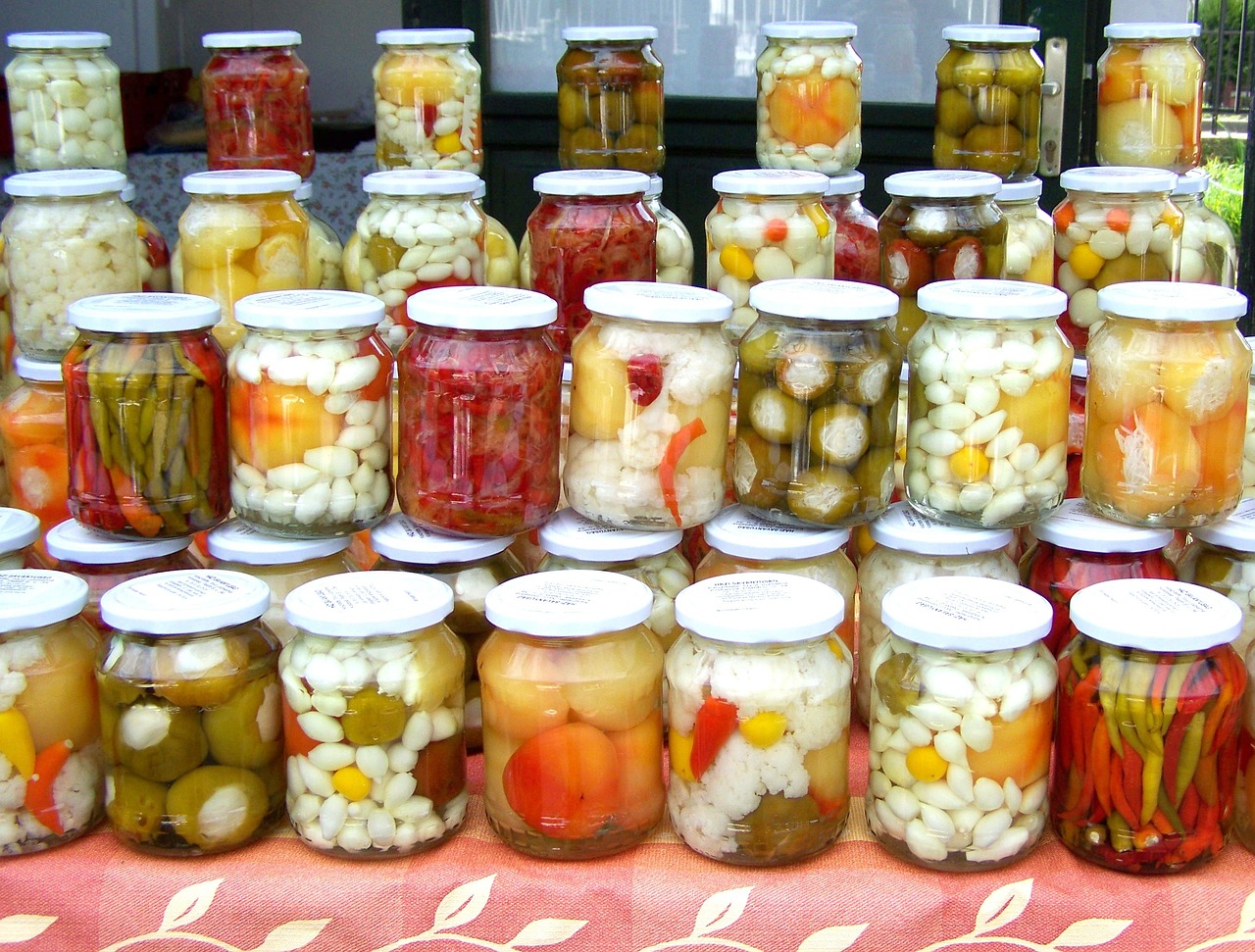
Healthy Treats for Cats
As a cat owner, you know that your furry friends deserve only the best, especially when it comes to treats. Making healthy treats for your cats not only shows your love but also helps ensure they receive the nutrition they need. Homemade treats can be a delightful surprise for your feline companions, and the best part is that you can control what goes into them. With just a few simple ingredients, you can whip up tasty snacks that will have your cats purring for more!
When it comes to crafting these delicious morsels, it's essential to focus on nutritious ingredients that cater to your cat's dietary needs. Cats are obligate carnivores, meaning they thrive on a diet primarily composed of meat. Therefore, incorporating high-quality protein sources is a must. For instance, using ingredients like chicken, tuna, or even turkey can make for some irresistible treats. But don’t forget to add a little flair! Ingredients such as catnip can elevate the flavor profile and make the treats even more enticing.
Here are two fantastic recipes that are not only simple to make but also packed with nutrition:
This recipe is a hit among cats, thanks to the combination of tuna and catnip. Tuna is rich in protein and omega-3 fatty acids, which are great for your cat’s coat and overall health. To make these tasty bites, you will need:
- 1 can of tuna in water (drained)
- 1 cup of oat flour
- 1 egg
- 1 tablespoon of dried catnip
Simply mix all the ingredients together, form small balls, and bake them at 350°F (175°C) for about 10-12 minutes. Let them cool before serving. Your kitty will be over the moon!
Another delightful option is chicken and rice balls. This recipe is not only delicious but also provides a good source of protein and carbohydrates. To prepare these, gather the following:
- 1 cup of cooked chicken (shredded)
- 1/2 cup of cooked rice
- 1 tablespoon of chicken broth (low sodium)
Mix all the ingredients in a bowl, roll them into small balls, and bake at 350°F (175°C) for about 15 minutes. These treats are perfect for training or just as a special reward!
As you embark on your homemade treat-making journey, remember to keep your cat's preferences in mind. Some cats may have specific tastes or dietary restrictions, so feel free to experiment with different ingredients while ensuring they remain healthy and safe. Always consult with your veterinarian if you're unsure about introducing new foods into your cat's diet.
Q: Can I use canned tuna in oil for treats?
A: It's best to use tuna in water rather than oil, as the oil can be too rich for your cat's diet.
Q: How often can I give my cat homemade treats?
A: Treats should only make up about 10% of your cat's daily caloric intake. Moderation is key!
Q: Are there any ingredients I should avoid?
A: Yes, avoid ingredients like onions, garlic, chocolate, and certain artificial sweeteners, as they can be toxic to cats.
Q: Can I freeze homemade cat treats?
A: Absolutely! You can freeze them in an airtight container, making them last longer and providing a refreshing snack on hot days.
Tuna and Catnip Bites
Are you ready to treat your feline friend to something truly special? are a delightful way to show your love while ensuring your cat enjoys a nutritious snack. These bites combine the irresistible flavor of tuna with the aromatic allure of catnip, making it a winning combination that most cats simply can't resist. Not only are these treats tasty, but they are also packed with protein and essential nutrients, making them a guilt-free indulgence for your beloved pet.
To whip up these scrumptious bites, you’ll need just a few simple ingredients. The star of the show is, of course, the tuna, which is rich in Omega-3 fatty acids that promote healthy skin and a shiny coat. Catnip, known for its stimulating effects on many cats, adds an extra layer of excitement to these treats. You can easily prepare these bites at home, ensuring you know exactly what goes into them, which is a huge advantage over store-bought options that may contain questionable fillers.
Here’s a quick look at the ingredients you’ll need:
| Ingredient | Benefits |
|---|---|
| Tuna (canned in water) | High in protein and Omega-3 fatty acids |
| Catnip | Stimulates playfulness and excitement |
| Whole wheat flour | Source of fiber and energy |
| Egg | Rich in protein and vitamins |
Making these treats is as easy as pie! Here’s a simple recipe to get you started:
1. Preheat your oven to 350°F (175°C). 2. In a mixing bowl, combine 1 can of drained tuna, 1 cup of whole wheat flour, 1 egg, and 1 tablespoon of dried catnip. 3. Mix until a dough forms. If the dough is too crumbly, add a little water until it holds together. 4. Roll the dough into small balls or flatten it and cut out shapes using cookie cutters. 5. Place the bites on a baking sheet lined with parchment paper and bake for about 10-12 minutes, or until golden. 6. Allow them to cool completely before serving them to your furry friend!
Not only will your cat love the taste of these , but you’ll also have the satisfaction of knowing exactly what they’re eating. Plus, these treats can be stored in an airtight container for up to a week, making them a convenient option for snack time. So, why not treat your cat to a little homemade goodness? They deserve it!
- Can I use fresh tuna instead of canned? Yes, fresh tuna can be used, but make sure it’s cooked and boneless.
- Is catnip safe for all cats? Most cats can safely enjoy catnip, but some may not react to it at all.
- How often can I give my cat these treats? Moderation is key! Treats should only make up a small part of your cat's diet.
Chicken and Rice Balls
If you're looking for a simple yet nutritious treat for your feline friend, then chicken and rice balls are a fantastic option! These little morsels are not only easy to make, but they also pack a punch of flavor and essential nutrients. Cats are obligate carnivores, which means they thrive on a diet rich in protein. By using chicken as the primary ingredient, you're ensuring that your pet gets the protein they need to stay healthy and active.
To make these delightful chicken and rice balls, you'll need just a handful of ingredients. The beauty of this recipe lies in its simplicity. You can use leftover chicken or even cook fresh chicken just for this purpose. Combine the shredded chicken with cooked rice, and you’re already halfway there! The rice acts as a binding agent, making it easier to form the mixture into balls that your cat will love. You can also add a dash of catnip for that extra flair; many cats go wild for it!
Here’s a quick breakdown of the ingredients you’ll need:
| Ingredient | Quantity |
|---|---|
| Cooked Chicken (shredded) | 1 cup |
| Cooked Rice | 1/2 cup |
| Egg (optional, for binding) | 1 |
| Catnip (optional) | 1 tsp |
Once you’ve gathered your ingredients, it’s time to get cooking! Start by mixing the shredded chicken and cooked rice in a bowl. If you decide to use an egg, beat it lightly and add it to the mixture. This will help bind everything together, making it easier to form into balls. If your cat enjoys catnip, sprinkle a bit into the mix for added flavor. After thoroughly combining the ingredients, roll them into small balls, about the size of a marble. Place them on a baking sheet lined with parchment paper.
Next, pop them in the oven at 350°F (175°C) for about 15-20 minutes. This not only helps to firm up the balls but also enhances the flavors, making them even more appealing to your furry friend. Once they are golden and firm, let them cool down completely before serving. Store any leftovers in an airtight container in the fridge, and they should last for up to a week. Your cat will be eagerly waiting for snack time!
These chicken and rice balls are not just a treat; they’re a great way to bond with your pet. Imagine watching your cat eagerly munching on these homemade delights, knowing you’ve provided them with a healthy and tasty snack. Plus, you can feel good about what you’re feeding them, as you have complete control over the ingredients. So, why not give this recipe a try? Your cat will thank you!
- Can I use other meats instead of chicken?
Absolutely! You can substitute chicken with turkey or even lean beef, depending on your cat's preferences and dietary needs. - Is it safe to add spices or seasonings?
While some spices are safe, it’s best to keep it simple. Avoid using salt, onion, or garlic, as these can be harmful to cats. - How often can I give these treats to my cat?
These treats should be given in moderation. They are a supplement to your cat's regular diet, not a replacement.
Frequently Asked Questions
- Why should I make homemade pet treats instead of buying them?
Making homemade pet treats gives you complete control over the ingredients, ensuring they are healthy and tailored to your pet's specific dietary needs. Plus, it can be more cost-effective than store-bought options!
- What are some safe ingredients I can use for pet treats?
Some great options include whole grains like oats, fruits such as apples and blueberries, and vegetables like carrots and sweet potatoes. These ingredients are not only safe but also packed with nutrients!
- Are there any common foods I should avoid when making pet treats?
Absolutely! Foods like chocolate, grapes, onions, and garlic are toxic to pets. Always double-check your ingredients to keep your furry friends safe and healthy.
- What if my pet has allergies?
No worries! You can use alternative ingredients like pumpkin or coconut flour instead of wheat, and ensure you avoid known allergens. There are plenty of recipes that cater to different dietary restrictions!
- Can I add supplements to my homemade pet treats?
Yes! Adding nutritional supplements like fish oil or probiotics can enhance the health benefits of your treats. Just make sure to consult with your vet to find the right supplements for your pet.
- How long do homemade pet treats last?
Typically, homemade pet treats can last about one week if stored in an airtight container in the fridge. You can also freeze them for longer storage, usually up to three months!
- Are there any easy recipes I can start with?
Definitely! Recipes like Peanut Butter and Pumpkin Biscuits or Tuna and Catnip Bites are simple and sure to please your pets. They are both nutritious and delicious!
- How do I know if my pet likes the treats?
The best way to find out is to watch their reaction! If they wag their tail, purr, or beg for more, you know you've hit the jackpot with flavor. Plus, you can always adjust the recipes to suit their tastes!



